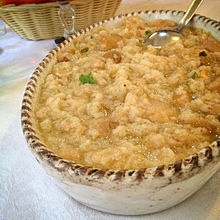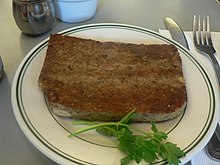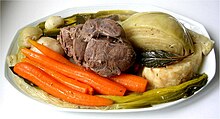Peasant foods
This article includes a list of general references, but it lacks sufficient corresponding inline citations. (March 2014) |

Peasant foods are dishes specific to a particular culture, made from accessible and inexpensive ingredients, and usually prepared and spiced to make them more palatable. They often form a significant part of the diets of people who live in poverty, or have a lower income compared to the average for their society or country.
Peasant foods have been described as being the diet of peasants, that is, tenant or poorer farmers and their farm workers,[1] and by extension, of other cash-poor people. They may use ingredients, such as offal and less-tender cuts of meat, which are not as marketable as a cash crop. Characteristic recipes often consist of hearty one-dish meals, in which chunks of meat and various vegetables are eaten in a savory broth, with bread or other staple food. Sausages are also amenable to varied readily available ingredients, and they themselves tend to contain offal and grains.
Peasant foods often involve skilled preparation by knowledgeable cooks using inventiveness and skills passed down from earlier generations. Such dishes are often prized as ethnic foods by other cultures and by descendants of the native culture who still desire these traditional dishes even when their incomes rise to the point where they can purchase any food they like.
Common types of foods
Meat-and-grain sausages or mushes

Ground meat or meat scraps mixed with grain in approximately equal proportions, then often formed into a loaf, sliced, and fried.
- Balkenbrij
- Goetta, a pork or pork-and-beef and pinhead oats sausage
- Groaty pudding
- Haggis
- Livermush
- Lorne sausage
- Scrapple, pig scraps, cornmeal and other flours and spices fried together in a mush
- Slatur
Meatloaves
Ground meat or meat scraps extended with crackers or bread and vegetables, then formed into balls, patties, or loaves and baked.
Pasta
Sauces

- Agliata – a garlic sauce in Italian cuisine that has been a peasant food, and also used by upper-class people[3]
Soups and stews
- Acquacotta, an Italian soup that dates to ancient history. Primary ingredients are water, stale bread, onion, tomato and olive oil, along with various vegetables and leftover foods that may have been available.
- Cholent, a traditional Jewish Sabbath stew
- Chupe, refers to a variety of stews from South America generally made with chicken, red meat, lamb or beef tripe and other offal
- Feijoada, a Brazilian dish originally made by slaves from leftover ingredients from their master's house
- Gazpacho,[4] typically a tomato-based vegetable soup, traditionally served cold, originating in the southern Spanish region of Andalusia.
- Minestrone, the meal in one pot of ancient Italy that is still a basic part of Italian cuisine
- Mulligan stew, a stew often made by itinerant workers
- Mujaddara, an Arabian dish of lentils, rice, grains, and onions
- Pea soup or "pease pudding", a common thick soup, from when dried peas were a very common food in Europe, still widely eaten
- Pot-au-feu, the French stew of oxtail, marrow, and vegetables, sometimes sausage
- Pottage, a staple stew made from boiling vegetables, grains and whatever was available, since Neolithic times in the British isles
- Ratatouille, the stewed vegetable dish
List of foods


- Baked beans, the simple stewed bean dish
- Barbacoa, a form of slow cooking, often of an animal head, a predecessor to barbecue
- Bulgur wheat, with vegetables or meat[5]
- Broken rice, which is often cheaper than whole grains and cooks more quickly
- Greens, such as dandelion and okra[5]
- Head cheese, made from boiling down the cleaned out head of an animal to make broth, still made
- Hominy, a form of corn specially prepared to be more nutritious
- Horsebread, a low cost European bread, that was a recourse of the poor
- Lampredotto, Florentine dish or sandwich made from a cow's fourth stomach
- Polenta, a porridge made with the corn left to Italian farmers so that land holders could sell all the wheat crops, still a popular food
- Pumpernickel, a traditional dark rye bread of Germany, made with a long, slow (16–24 hours) steam baking process, and a sour culture
- Ratatouille, the stewed vegetable dish
- Red beans and rice, the Louisiana Creole dish made with red beans, vegetables, spices, and leftover pork bones slowly cooked together, and served over rice, common on Mondays when working women were hand washing clothes
- Salami, a long lasting sausage, used to supplement a meat-deficient diet
- Soul food, some aspects come from foods that could be taken on a transatlantic passage
- Succotash, a blend of corn and beans
- Taco, foods placed on native flat breads in South and North America
-
A slice of pumpernickel bread
See also
- Famine food, foods turned to in times of crisis, sometimes across whole societies
- Farm-to-table
- Slow Food, a social movement inspired by home cooking and regional tradition as an alternative to fast food
- Social class
- Traditional knowledge
References
- ^ Albala, Ken (2002). Eating Right in the Renaissance. University of California Press. p. 190. ISBN 0520927281.
- ^ Viaggio in Toscana. Alla scoperta dei prodotti tipici. Ediz. inglese. Progetti educativi. Giunti Editore. 2001. p. 41. ISBN 978-88-09-02453-3.
- ^ Capatti, A.; Montanari, M.; O'Healy, A. (2003). Italian Cuisine: A Cultural History. Arts and Traditions of the Table: Perspe (in Italian). Columbia University Press. p. 36. ISBN 978-0-231-50904-6.
- ^ Daly, Gavin (2013). The British Soldier in the Peninsular War: Encounters with Spain and Portugal, 1808-1814. Palgrave Macmillan. p. 100. ISBN 1137323833.
- ^ a b Ciezadlo, Annia (2012). Day of Honey: A Memoir of Food, Love, and War. Simon and Schuster. p. 217. ISBN 1416583947.
Further reading
- Bryceson, Deborah Fahy (1978). Peasant Food Production and Food Supply in Relation to the Historical Development of Commodity Production in Pre-colonial and Colonial Tanganyika. Service paper / University of Dar es Salaam. Bureau of resource assessment and land use planning. 72 pages.
- Dyer, Christopher (1989). Standards of Living in the Later Middle Ages: Social Change in England C.1200-1520. Cambridge University Press. Chapter 6. pp. 151- . ISBN 0521272157
- Brierley, John S.; Rubenstein, Hymie (1988). Small farming and peasant resources in the Caribbean. Dept. of Geography, University of Manitoba. Volume 10 of Manitoba geographical studies. Chapter 1.
- Fieldhouse, D.K. (2012). Black Africa 1945-1980: Economic Decolonization and Arrested Development. Routledge p. 146. ISBN 113687822X
External links
- Dietary Requirements of a Medieval Peasant. People.eku.edu.


